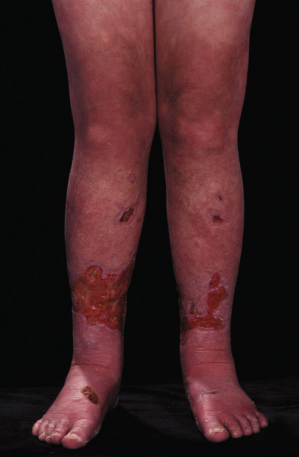In total, 62% of children and young people have symptoms in the legs only; in 38% the arms and legs are affected [26]. Clinical onset has been reported before the age of 1 year and usually occurs before the end of the first decade [27]. Pain occurs when a constant peripheral skin temperature is reached. The temperature is different for each patient but is usually between 32°C and 36°C. The pain is of differing intensity in different individuals. Most commonly, it is confined to the feet or hands; it rarely spreads to the knee or elbow [28]. Pain may occur in relation to walking, standing, exercising, sleeping under covers, wearing shoes or gloves, or placing the extremity near a heater. Many patients report increased frequency or intensity of attacks in summer [29,30]. Pain is also said to be worse later in the day and at night [31]. Attacks last from a few minutes to 2–3 h but some may last for 1–2 days.
Many patients place their limbs in cold water or ice to gain relief (some authors consider this pathognomonic of the disease) [32]. This causes many complications, including superficial ulceration (Fig. 166.2), secondary infection, maceration and gangrene, and has resulted in amputation [33,34].
Thermography can show differences of up to 9°C between the affected and unaffected areas of skin [35].
Prognosis.
Historically, the results of therapy have been poor. Many patients diagnosed in childhood have continued to have symptoms in adulthood. The disease may follow a chronic, sometimes progressive and disabling course [32]. Conservative measures such as avoidance of heat and exercise may result in remission. There are reported cases of amputation and self-harm including suicide because of the intensity of the pain [5,23].
Differential Diagnosis.
Reflex sympathetic dystrophy is characterized by chronic incapacitating pain in the extremities. This is thought to be due to increased sympathetic nervous system activity. Patients present with cool, mottled extremities, which have poor pulses. Symptoms are unchanged by dependency and heat. Patients may benefit from sympathetic blockade.
Angiodyskinesia syndrome is predominantly a disease of young females. They develop a blotchy erythema on standing. This may be associated with paraesthesia, pain or a burning sensation, but the sensation most commonly referred to is a ‘painful heaviness’. Angiography has demonstrated early venous return with narrowed arteries and no microvascular abnormalities. Therapies used with mixed success have included vasodilators and sympathectomy.
Fabry disease is an X-linked sphingolipid storage disorder in which there is a deficiency of α-galactosidase A. This results in angiokeratomas, corneal dystrophy, mitral valve disease and renal failure. It can present with acute painful crises following exercise, emotional stress and acute changes in temperature or humidity. Painful crises may occur prior to the appearance of angiokeratomas.
Treatment.
There are no randomized controlled trials of therapy for erythromelalgia. The literature contains case reports and a single-case cross-over study. Case definition is poor in many reports. Treatment is often complex and may require multidisciplinary input.
Non-Medical Approaches
The successful use of hypnotherapy and biofeedback has been reported in small numbers of adolescents and adults [32,36].
Topical Therapy
There are a number of individual case reports of the successful use of topical therapy. A combination of topical 1% amitriptyline hydrochloride and 0.5% ketamine hydrochloride resulted in a marked improvement in a small group of patients [37]. Five percent lidocaine patches have also resulted in improvement of symptoms when applied to areas that were painful [38].
Oral Therapy
Response to aspirin is poor (although a beneficial effect is more common in the secondary form of the disease) [39]. Aspirin has been used with effect in conjunction with propranolol (10 mg/kg twice per day) and carbamazepine (at an antiepileptic dose) [11]. Gabapentin in a 9-year-old girl at a dose of 300 mg three times per day resulted in resolution of symptoms [40]. Oral mexilitene, an orally administered analogue of lidocaine, has also been reported to be effective, without adverse effects [41]. Mexilitene is a class 1B antiarrythmic drug, normally used as a local anaesthetic agent, and works by blocking sodium channels. Oral ciclosporin and other immunosuppressant drugs have also been used.
Stay updated, free articles. Join our Telegram channel

Full access? Get Clinical Tree









